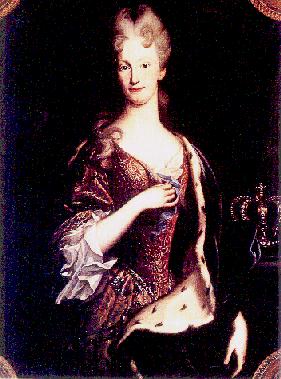Elizabeth Farnese 1574
- Born: 25 Oct 1692 1574
- Marriage: Philip V King of Spain on 24 Dec 1714 1573
- Died: 11 Jul 1766 at age 73 1574

 General Notes: General Notes:
Elizabeth & Philip V had seven children: Charles III, Francisco, Marianne Victoria of Borbón, Philip, Duke of Parma, Maria Teresa, Luis Antonio & María Antonieta.
Elizabeth Farnese (October 25, 1692 - July 11, 1766), Queen consort of Spain, also known as Isabel de Farnesio or Isabella Farnese, was the only daughter of Odoardo II Farnese, Duke of Parma. Her paternal grandfather was Ranuccio II Farnese, Duke of Parma.
Maternal ancestry
Her mother Dorothea Sophie von Neuburg was a daughter of Philipp Wilhelm, Elector Palatine and Elisabeth Amalie Magdalene of Hesse-Darmstadt. Her maternal grandparents were Georg II, Landgrave of Hesse-Darmstadt (1605-1661) and Sofie Eleonore, Princess of Saxony (1609-1671).
Sofie Eleonore was in turn a daughter of John George II, Elector of Saxony and Magdalene of Brandenburg. Her maternal grandparents were Albert Frederick, Duke of Prussia (1553-1618) and Marie, Princess of Cleve-Julich.
Marie was a daughter of William III, Duke of Cleves and a granddaughter of John III, Duke of Cleves. Her mother Marie von Habsburg, Archduchess of Austria was a daughter of Ferdinand I, Holy Roman Emperor and Anne of Bohemia.
Anne of Bohemia was herself a daughter of Ladislaus II of Bohemia and Hungary and Anne de Foix.
Life account
Her mother educated her in strict seclusion, but seclusion altogether failed to tame her imperious and ambitious temper. At the age of twenty-one (1714) she was married by proxy at Parma to Philip V of Spain. The marriage was arranged by Cardinal Alberoni, with the concurrence of the Princess des Ursins, the Camarera Mayor.
On arriving at the borders of Spain, Elizabeth was met by the Princess des Ursins, but received her sternly, and, perhaps in accordance with a plan previously concerted with the king, at once ordered her to be removed from her presence and from Spain. Over the weak king Elizabeth quickly obtained complete influence. This influence was exerted altogether in support of the policy of Alberoni, one chief aim of which was to recover the ancient Italian possessions of Spain, and which actually resulted in the seizure of Sardinia and Sicily. So vigorously did she enter into this policy that, when the French forces advanced to the Pyrenees, she placed herself at the head of one division of the Spanish army.
But Elizabeth's ambition was grievously disappointed. The Triple Alliance thwarted her plans, and at length in 1720 the allies made the banishment of Alberoni a condition of peace. Sicily also had to be evacuated. And finally, all her entreaties failed to prevent the abdication of Philip, who in 1724 gave up the throne to his heir, and retired to the palace of La Granja.
Seven months later, however, the death of the young king recalled Philip to the throne. During his later years, when he was nearly imbecile, she directed the whole policy of Spain so as to secure thrones in Italy for her sons. In 1736 she had the satisfaction of seeing her favorite scheme realized in the accession of her son Don Carlos (afterwards Charles III of Spain) to the throne of the Two Sicilies and his recognition by the powers in the treaty of Vienna. Her second son, Philip, became duke of Parma. Elizabeth survived her husband twenty years. 1573

Elizabeth married Philip V King of Spain, son of Louis, the Grand Dauphin and Maria Anna Duchess of Bavaria, on 24 Dec 1714.1573 (Philip V King of Spain was born on 19 Dec 1683 in Versailles, Île-de-France, France 1574 and died on 9 Jul 1746 1574.)
|

 General Notes:
General Notes: 